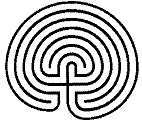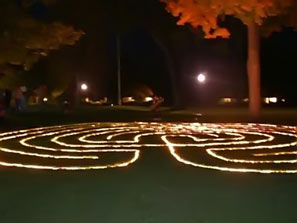Labyrinth of Light
by Bethe Hagens
bethehagens@gmail.com
Labyrinth of Light: Metaphor for a Learning Community
"Professor" shouted Harry, seizing Dumbledore's arm. "Quick! Do something!"
Dumbledore looked down at Harry with a patient expression. "Do something, Harry? Your very formulation exposes the vacuity of your intellectual premises. One does not do a thing ; one engages with a processual framework that is continuously negotiated at the margins of meaning and action. . ."
A. & S. Buckser , Anthropology News , January 2004, p64
One of the things about art-based research is that you don't necessarily set off one morning and say, "OK! I think today I'll start an art-based research project!" You might only realize in process that you're doing one; or when someone labels your work that way; or in retrospect when you look at what's materialized and sit back with a grin and think, "This is good. This is really good! Look at all those metaphors!!"


And so. . . In the Beginning, I decided to set a cobblestone labyrinth into my front lawn over the septic system drainage field. I had found a neat trick on the internet for drawing the "classic seven-path" pattern from a geometric "seed" (shown at the left). This graphic seed generates a whole set of other ancient designs, and I was smitten. I immediately set to work with a butcher knife to cut 4" wide strips in the sod and a pancake spatula to remove them. I planned then to lay stones in the concentric troughs. ( http://www.lessons4living.com/drawing.htm )

On the awful morning of September 11th, the second Trade Tower collapsed just as my labyrinth's cobblestones slid from the delivery truck onto my driveway. For the next ten days, I ignored the television and worked from dawn to dusk out in my yard. Children in the neighborhood immediately began to help me lay in stones, and they soon established a ritual of running to the center, stretching out their arms, making a wish, and then running out again. Sometimes as many as eight or ten of them would be racing around the labyrinth at once, and they reminded me of the tigers in Little Black Sambo... their fears melting into butter for pancakes.
( http://www.sterlingtimes.co.uk/sambo.htm )
About this time, my university "acquired" Vermont College with great fanfare and talk of "rejoining the clans." The merger, of course, proved to be quite difficult. The two schools seemed mired in incompatible plans and protocols. Both are primarily distance education oriented, and the main Union campus in Cincinnati is a thousand miles from Montpelier . About a year and a half into the process, I was in Vermont having drinks and dinner one beautiful spring evening with a new dean and new colleague, and we realized that we would all be on-campus at the same time for several days later in the year doing our separate activities. We got to thinking that we could hold some events in common. Light bulbs went on. I ordered a second caesar salad. We'd call the time period an all-university Symposium and, by just being together, begin to break down some of the barriers we were all experiencing. We needed a theme, and I suggested Thresholds . The dean, a poet and political scientist, suggested Margins and Thresholds. My colleague, a lesbian activist, liked that a lot. (Later, we settled on Margins, Boundaries and Thresholds because it had a nice ring, and the Alumni Office added Creativity Across the Disciplines).
Another normally more staid dean joined us at the bar. He is an organist and I am a violinist, and we literally started jumping up and down when we realized that the Symposium could provide a venue for us to perform in the magnificent College Hall with its restored pipe organ as part of our jobs! We'd invite everyone in the Union Institute & University/Vermont College community-alums, current students, faculty, staff-to come to Vermont . Fall foliage festivities already planned in town would only augment whatever we came up with. Why, we'd invite our star alum, Shaun McNiff, as keynote presenter. We couldn't fail. The path was already laid out. There was no sense of urgency, no purpose other than to be together. We decided then and there to bypass the tortuous maze of cross-institutional academic process and review by offering the Symposium without any overarching academic or C.E.U. credit attached. Something in me said, "This is going to be a piece of cake."
Why I didn't turn and run is beyond me. If there is a hallmark of my own art-based research, it is that whatever it turns out to be, it will not be a piece of cake. But my anthropologist heart begins to pound-I really do like the liminalities and possibilities of creating new community connections-and my adrenalin soars. I can't stop working and I keep going until I get sick. . .or, until the art-based element kicks in and I shift gears.
It's both more frustrating and more exciting for me when I move out of "my own work" and into a project such as the Symposium which must be collaborative. In the kinds of projects I like, a point-person is often needed, and I am usually willing to take on the role because it seems so simple. Inevitably, after the initial excitement, the realities of what I have taken on and what others can or cannot commit become painfully obvious. In the case of the Symposium, loyalties, budgets, space, maternity and sick leaves, external academic program reviews, and a litany of other obligations brought what could only be called a stunning groundedness to our path. I think my largest contribution to the event was simply assuming that it would happen and continuing to project that belief even as our planning mechanisms seemed to grind to a complete halt. A detail would be set in place, and then a staff lay-off or position transfer would occur. Everything would be wrapped up on a mailing, and then an objection would arise from an as yet unidentified oversight administrator in an office that had just been created. As often as we'd circle the troops to celebrate completion, we'd be back at the beginning. It wasn't so much a matter of taking wrong paths, it was simply walking the same one over again and again and again.
By summer, Dark Times had descended. The collaborators were weary and needed a break, but I still couldn't stop. The pattern is so familiar to me. I eat dinner at my computer, skip my daily walks, use more under-eye concealer, slog through the details (e.g. confirmations, incompatible LCD hookups, lost space reservation forms, angry faculty who will not pay for their rooms if They don't have to), and climb in bed with my students' dissertations. I am seriously Tired.
And then, out of nowhere, It appears! This time It is on my friend's coffee table-in a book. I take a weekend off from conference planning and do a crash course on It. I'm in ecstasy imagining doing It-and I can ONLY do it if the Symposium happens. This realization re-energizes my process and my vision of the event, and I have another "this will be a piece of cake" experience in the Great Chain of Art-Based Being. I will build a labyrinth during the Symposium at the Vermont College campus, and it will be so beautiful!!! I think no further. There is no other reason.
I return to Symposium planning a changed woman. Part of me moves into the technicalities of labyrinth construction: the cheapest supplies; the best design; safety and durability issues; locating a site; the possibility of snow. . . I never question that it will happen. The labyrinth creates itself before my eyes as I immediately eliminate candles (my boyfriend imagines the long skirts of wispy Vermont ladies flaming in the night) and settle upon rope lights, only to realize that the power I need could trip a circuit breaker and shut down the electrical system in the main hall! These considerations exactly mirror other Symposium processes in which I am engaged (tight budgeting; competing demands for choice program spots; scrambled communications between me in Kennebunkport and cafeteria, facilities, and housing staff a thousand miles apart; uncertain space availability), but I still don't see that they are one circuitous path and not a maze.
I make repeated trips to the beach to practice drawing labyrinths in the sand and then several to Montpelier to stake out a site and press the geometric seed onto the ground in powdered lime. A month before the symposium, I lime the complete pattern and discover I will eventually need 568 feet of rope lights. Lay-offs at school have been rumored, and the cost of the lights astounds me. I buy them and think of how pretty my house will look at Christmas. I buy 600 feet of equally expensive extension cords, brown, to match the ground. . .Rain comes. Almost all the lime is washed away, but campus collaborators email me to say enough can still be seen to restore it! I do. And then do it again. . . I still don't see the metaphor. I am still eating at the computer, emailing while I am talking on the phone and collating program components.
Only when writing text for my exhibit that accompanied my "landscape sculpture" (aka Labyrinth of Light) did I begin to see our labyrinthian planning path. A labyrinth differs from a maze in that it is a single path. There is no possibility for a wrong turn. One simply makes a decision to walk it. In surrendering to the journey of a labyrinth, being drawn almost to the center, then out to the periphery, and then finally to the center, one can let go of mind and purpose and relax into the meditative spontaneity of individual Fate. The point of departure is the point of return. There is nowhere to go but inside. Nothing to do but walk the same path out again. . .if you're an adult. . .

Children aren't saddled with the Greek and Roman understanding of the Minotaur trapped in the prison of the labyrinth; and adults rarely learn that it was also believed to be a place of rebirth and protection. For several hundred years after 1000 C.E., labyrinths were the site for winter solstice celebrations in Christian churches and they became synonymous with the inescapable path of Fate that Jesus would walk towards his crucifixion. German and Italian churches incorporated the images of both a fruiting "tree-cross" (shown here from the 12 th century Book of Illustration ) which symbolized Christ's victory over death, and a leafed tree of knowledge bearing a crucified Christ.
I saw our process. A rose in full bloom.

I had been so consumed with the elegance of the geometric seed that I didn't realize until I actually installed the rope lights that I would need two separate strands to make the pattern. Two separate institutions to create the liminal tensions of the Margins, Boundaries and Thresholds of the Symposium. The tree cross morphed for me into a healing staff, entwined by two snakes, of DNA, and then into a brain, a solar system, a galaxy-all leading to the black hole center of all-consuming creative Self. A book I will write materialized before my eyes as I finally understood the labyrinth as the connector for winter solstice symbols I had been working with since the early 1990s.

The Symposium was wonderful. We were blessed with gorgeous early October weather, and participants as well as people from all over Montpelier came with their families to wander the labyrinth long into the night. Children raced around yelling, and, oblivious to the lines, toddlers tried to drag their more wary parents to the center. I saw women dancing in the moonlight.
I don't know what will come of our hopes for campus unity that brought the Symposium and labyrinth into existence. These are uncertain times in higher education, particularly for a Ph.D. program such as ours which has evolved, over forty years, into a pedagogical model now all but indistinguishable from the process of art-based research. How will we-as individuals, and as an institution-continue along our path while simultaneously opening to a Federally mandated and regulated shift in focus toward outcomes-based assessment?
Whenever I try to approach this question directly, I realize that I am betraying the method I'm trying to protect. One solution to this problem has been to shift the dialogue to the archetypal realm. I'm thinking now of the wise and compassionate Yudhishthira, a central figure in the Hindu creation epic, The Mahabharata. When Yudhishthira is told that war is inevitable, he says, "We cannot change what is destined to be, but I shall do nothing in thought, deed and action to provoke it." Ironically, though, he has a weakness for gambling. He is terrible at it, yet he lets himself be lured into a game in which he stakes not only his entire kingdom and wealth, but his brothers and his beloved wife. He cannot stop playing, even as he loses everything, sends himself and his family into exile, and ultimately brings about the Great War that breaks the log-jam that has held back Creation. Yudhishthira's final realization is that every path is an illusion, that there is no winning or losing, only integrity to self. With this recognition he finds peace.
In her 1999 Union Ph.D. dissertation, Art-Based Research in Dan ce/Movement Therapy, Lenore Hervey essentially defined art-based research as integrity to self. "Artistic inquiry uses artistic methods of gathering, analyzing, and/or presenting data; engages in and fully acknowledges a creative process; and is motivated and determined by the aesthetic values of the researcher(s)." If the doing of art-based research is our passion, our love, our desire-then we are as a community the process of world peace. As we claim and live this identity, a more powerful and visible global human ethic will emerge as the shape of our path.
Bibliography:
Bannerman, H. The Story of Little Black Sambo . Retrieved March 15, 2004 , from http://www.sterlingtimes.co.uk/sambo.htm
Buckser, A., & Buckser, S. (2004). Harry Potter and the shaman's t ent: Sneak preview. Anthropology News, 45 (1), 56.
Carriere, J.-C. (1990). The Mahabharata: A viewer's guide to Peter Brook's epic film . New York : Parabola Video Library.
Gell, A. (1999). The art of anthropology: essays and diagrams (Vol. 67). London : The Athlone Press.
The Herder symbol dictionary: Symbols from art, archaeology, mythology, literature, and religion . (B. Matthews, Trans. First ed.)(1986). Wilmette : Chiron Publications.
Hervey, L. W. (2000). Art-Based Research in Dan ce/Movement Therapy . Springfield , IL : Charles C. Thomas, Publisher, Ltd.
Johnston, D. (2004, April 2, 2004 ). How to draw a seven-circuit labyrinth . Retrieved March 15, 2004 , from lessons4living.com/drawing.htm
Kern, H. (2000). Through the labyrinth: designs and meanings over 5000 years . Munich : Prestel.
Mullen, C. A., & Finley, S. (Eds.). (2003). Arts-Based Approaches to Qualitative Inquiry (Vol. 9(2)). Thousand Oaks: Sage Publications.
Bethe Hagens, Ph.D.
Core Doctoral Faculty, Interdisciplinary Studies
Union Institute and University
These files are protected by a Creative Commons license. Any of the information and graphics may be copied and freely shared as long as (1) the author and source are cited; (2) the Creative Commons license is acknowledged; and (3) the material is not sold. Please contact me if you have a question about using any of these materials.